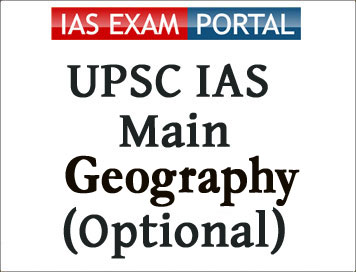(HOT) UPSC Current Affairs 2025 PDF
NEW! The Gist (NOV-2025) | E-BOOKS
UPSC Main: Strategy for Geography (Optional)

UPSC Main: Strategy for Geography (Optional)
Geography as an optional subject has become very popular since the introduction of new scheme in 1979 for Civil Services Examination. The subject has a scientific flavour and is objective and analytic. It is this scientific nature of subject which has made geography a very popular optional. The past performance of candidates clearly reveals that the subject is highly scoring and reliable. Also, unlike common belief, the subject is not vast and can be easily prepared in 2-3 months time if worked systematically.
The syllabus for the Mains examination has two papers : Paper-I deals with the Principles of Geography whereas Paper-II encompasses Geography of India. Very often, these two papers are taught or studied in isolation, which is a wrong approach. In fact, the two papers are intricately related. In Paper I fundamental principles of Geography are to be learnt and in Paper-II the fundamental principles learnt in Paper I are to be applied in the context of India. Thus, Paper I is concerned with understanding of concepts and Paper II seeks the application of those concepts. Prepared this way, the subject becomes objective, analytic, less time-consuming, very little or no mugging is required, and gives advantage over all other subjects of humanities and social science.
Geography can be taken as an optional by any candidate who has a scientific temper and average level of intelligence. Elementary understanding of concepts of everyday science is an asset. It is specially recommended to Science and Social Science graduates and also for those who do not have very good command over language.
Like any other subject, guidance by properly trained subject experts, i.e. Geographers; specially those teaching in universities and who have a feel of Civil Services Examination system can greatly help students in the preparation and getting best and of limited time. Fortunately, proper guidance in geography is available in most of the major cities of India. But students must take guidance from the right persons, otherwise guidance from untrained, self-proclaimed geography expects can even harm their interest.
Besides understanding the concepts, more important from the point of view of Civil Services examination is writing answers and, if possible, getting them properly evaluated.
Paper 1
Five questions are to be attempted; out of which two questions are compulsory—one on map and the second on short notes. Three full length questions to be attempted — two from one section and one from the other section. For question on map, the student is given the option of World or India map. If you have familiarity with world, then you may opt for World map otherwise concentrate on India. For question on map, students should practice map filling on blank maps. Try to learn using proper symbols for map filling. Also, one has to write in 10 words about the location asked. For this, one should write the most salient feature of the location.
For other four questions students should first understand all the basic concepts given in the syllabus and then focus on the more important concepts that can be found out from past years question papers or from a proper guide.
Three full length questions are to be attempted. Students should try to attempt two questions from Section A (Physical Geography) as these questions are comparatively more scoring. The important topics are Geomorphology, Climatology, Eco-System, Settlement Geography and Economic Geography. Some questions on Political Geography and Human Geography are also very scoring.
Paper 2
As mentioned earlier, Paper II is to be taken as the case study of India i.e. application of the geographical concepts in Indian context. Thus, students should try to examine and explain the spatial patterns in India with the help of concepts learnt in Paper I.
Traditional Geography books on India are far from satisfactory; specially with respect to socio-economic aspects as books on Geography of India have narrow and limited vision and data are not recent. The students need to develop a holistic view and here a proper guidance can help a lot. In Paper II, for getting high score, a holistic approach plays a very important role. Also, students should understand and study any one region of India in detail as many questions ask to write your answer with reference to any region with which you have familiarity.
The important topics in Paper II (keeping in view scoring as well) are Physical aspect, Resources, Agriculture, Industry, Regional Development and Planning.

